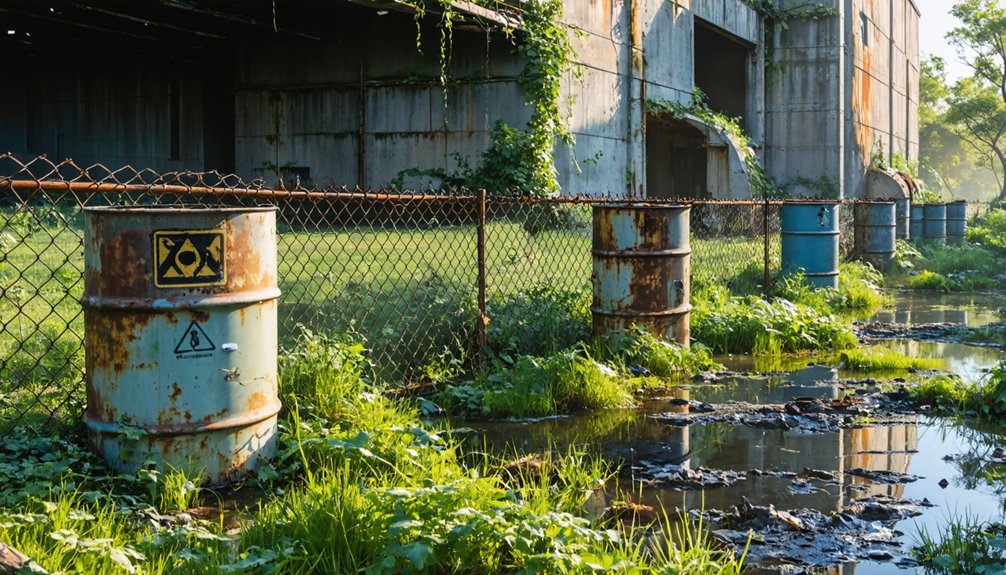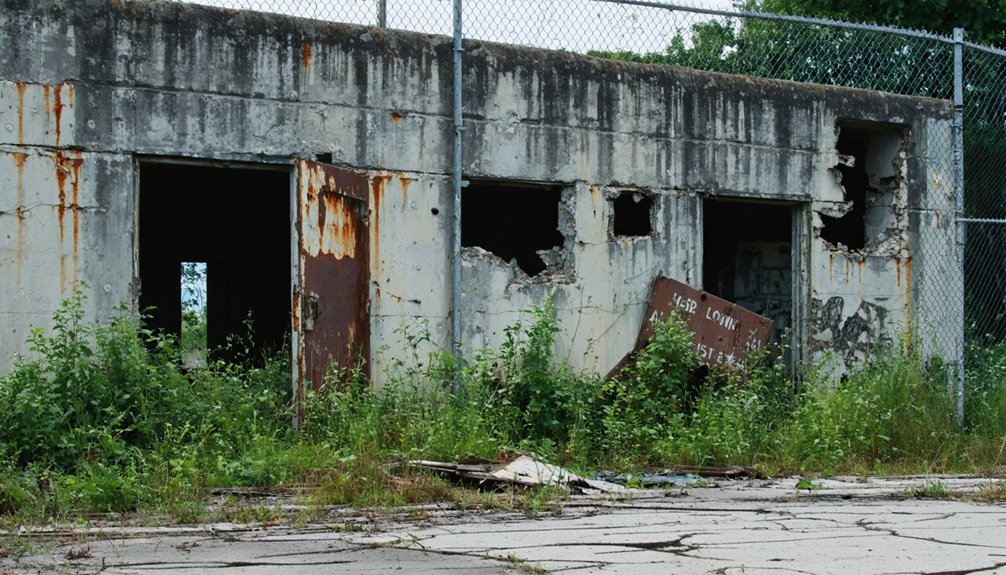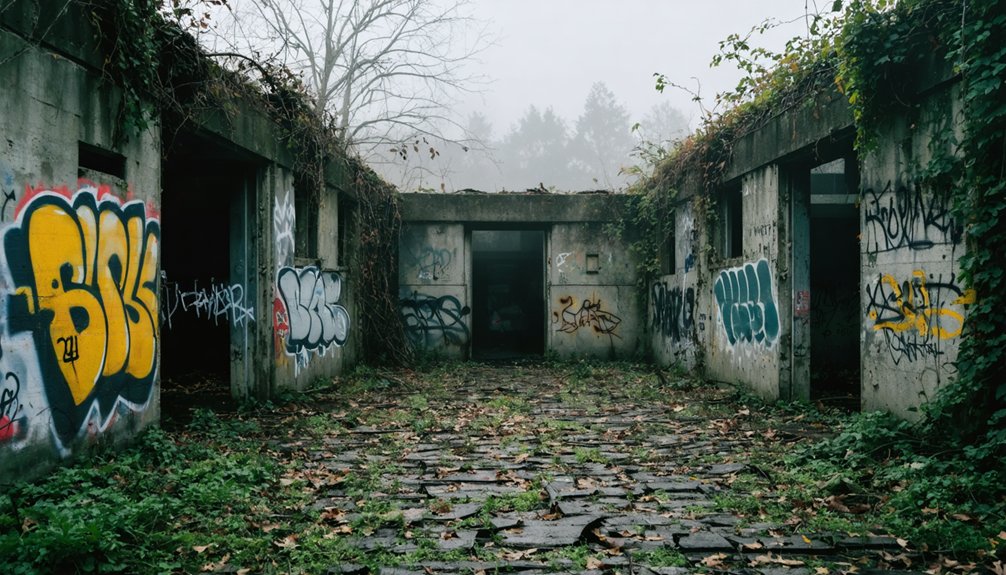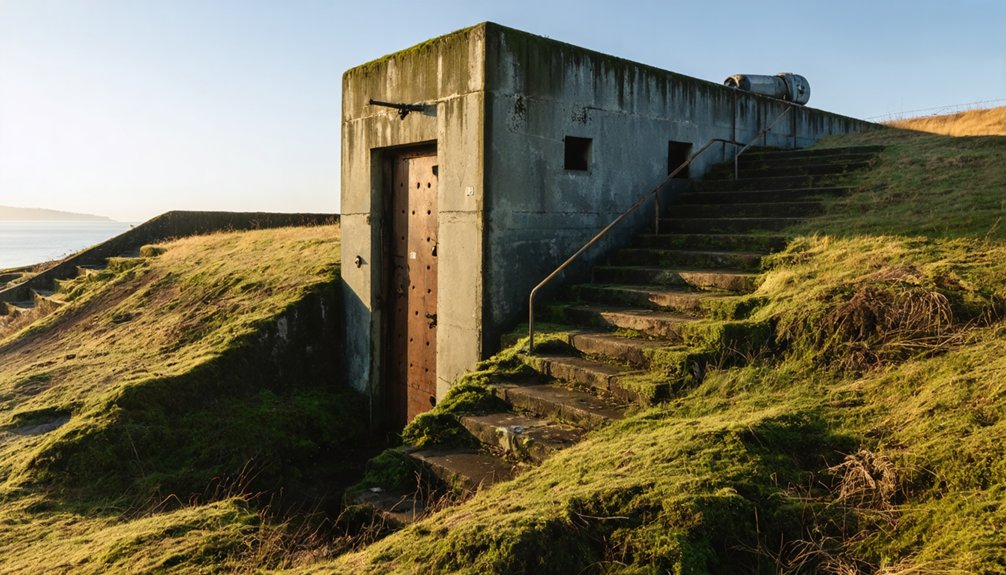You’ll find hundreds of abandoned military bases across America, transformed into ghost towns following the BRAC program that closed over 350 installations since 1988. These sites feature deteriorating barracks, vacant hangars, and infrastructure reclaimed by nature. They represent complex legacies of environmental contamination, reported paranormal activity, and economic devastation for surrounding communities. Some bases have been repurposed, while others remain frozen in time—their stories waiting beneath crumbling foundations.
Key Takeaways
- BRAC initiatives closed over 350 military installations since 1988, creating numerous ghost towns across America.
- Abandoned bases often contain environmental hazards including chemical warfare remnants and PFAS contamination.
- Many former military installations have been transformed into thriving civilian hubs through strategic redevelopment.
- Military ghost towns attract urban explorers seeking connections to defense history and unique architectural elements.
- Several abandoned bases are reportedly haunted, with documented sightings of spectral military personnel in historical uniforms.
The Legacy of BRAC: How Military Ghost Towns Were Born
When examining the birth of America’s military ghost towns, one must understand the Base Realignment and Closure (BRAC) Commission established by Congress in 1988. This bipartisan, independent body was designed to tackle inefficient military spending and excess infrastructure while remaining insulated from political influence.
Through five rounds (1988-2005), BRAC transformed America’s military landscape by closing over 350 installations and saving an estimated $12 billion. The commission’s unique legislative process prevented partisan protection of bases—Congress could only approve or reject the entire list without amendments.
The resulting BRAC transformations created numerous abandoned installations across the country. These derelict sites, rich in military heritage, became ghost towns that now stand as cultural landmarks. The initial BRAC list, approved in January 1989, immediately targeted eighty-six facilities for closure, setting the precedent for future massive military downsizing.
From military strongholds to silent sentinels—BRAC’s legacy of abandoned bases chronicles America’s shifting defense priorities in concrete and steel.
While some bases were repurposed for civilian use, others remain abandoned, attracting urban explorers and generating paranormal legends. The transparent deliberations of the commission included open hearings and solicitation of public feedback to ensure accountability throughout the closure process.
Fort Ord: A Case Study in Abandonment and Contamination
Although once a sprawling military installation spanning 28,000 acres along California’s central coast, Fort Ord now represents one of America’s most significant case studies in post-military contamination and abandonment challenges. Established in 1917 and officially closed in 1994, the base’s legacy includes extensive environmental damage from munitions, depleted uranium, and other hazardous materials that earned it Superfund site status.
You’ll find Fort Ord’s transformation illustrates the complex intersection of military withdrawal and public health concerns. While community redevelopment efforts have converted portions into residential zones, educational facilities, and conservation areas, ongoing cleanup operations continue addressing contamination that potentially endangers thousands who now live and work on former base lands. The Fort Ord Reuse Authority (FORA) was established to manage this difficult transition process from military use to civilian purposes.
This balancing act between redevelopment and remediation defines Fort Ord’s complicated shift to civilian use. The base trained approximately 1.5 million soldiers from 1940 to 1975, serving as the chief training center during the Vietnam War.
Paranormal Hotspots: The Supernatural Side of Deserted Bases
You’ll find that deserted military installations across America harbor an extraordinary number of paranormal phenomena, including apparitions of uniformed personnel and unexplained auditory disturbances that correlate with traumatic historical events.
Abandoned structures within these bases—particularly barracks, hospitals, and disciplinary facilities—serve as focal points for supernatural activity, with F.E. Warren Air Force Base, Fort Leavenworth, and Plattsburgh Air Force Base representing some of the most documented paranormal hotspots.
These haunted locations frequently manifest poltergeist-like disturbances, shadowy figures, and electrical anomalies, phenomena which have attracted serious investigation from ghost hunters and parapsychologists seeking to understand the connection between military history and residual spiritual energy. Many service members have shared chilling experiences that continue to add to the paranormal lore of these abandoned sites. The USS Hornet, with over 300 deaths recorded on board, offers overnight stays for visitors brave enough to experience its intense paranormal activity firsthand.
Ghostly Military Personnel
Beyond the crumbling infrastructure and abandoned facilities of America’s deserted military bases lies a persistent phenomenon that defies conventional explanation: the spectral presence of former military personnel.
At sites like Plattsburgh Air Force Base and Vancouver Barracks, you’ll encounter reports of shadowy figures in period uniforms patrolling grounds they once protected. These ghostly encounters often manifest as phantom footsteps, disembodied commands, or full-bodied apparitions. The residual emotions from historical conflicts contribute significantly to these paranormal manifestations.
Spectral soldiers from various eras have been documented at F.E. Warren Air Force Base, where Native American warriors and military personnel allegedly coexist in the afterlife. Mysterious doors have been reported to creak open by themselves, startling personnel stationed at these haunted locations.
Most haunting activities center around locations with tragic histories—hospitals that treated dying soldiers, barracks where suicides occurred, and execution sites. The trauma associated with military service appears permanently imprinted on these abandoned spaces, creating paranormal hotspots that continue to generate inexplicable phenomena.
Unexplained Base Phenomena
What separates ordinary abandoned military installations from true paranormal hotspots lies in the consistent patterns of unexplained phenomena documented across decades of observation.
You’ll find these manifestations concentrate in specific locations like Fort Leavenworth’s 40 haunted structures or Plattsburgh’s Old Stone Barracks, where multiple soldier suicides occurred.
These spectral encounters follow recognizable patterns: environmental anomalies including localized temperature drops and electrical disturbances; auditory phenomena like phantom footsteps and disembodied voices echoing through elevator shafts; and visual apparitions of both historical and contemporary figures vanishing before witnesses. Popular television shows such as Ghost Hunters have featured these locations with compelling evidence of paranormal activity.
Most compelling are the poltergeist activities—doors opening independently, objects disappearing, and lights functioning without power sources—documented by numerous independent witnesses across different time periods, suggesting these aren’t merely structural anomalies but genuine paranormal manifestations.
Historic Hauntings Revealed
Throughout America’s abandoned military landscape, certain locations have transcended mere dereliction to become renowned paranormal hotspots with documented supernatural activity spanning decades.
Fort Leavenworth and Fort Mifflin stand as monuments to this haunted history, where spectral soldiers in period uniforms patrol grounds that witnessed executions and battles centuries ago.
You’ll encounter distinct paranormal patterns across these bases—apparitions in military attire, autonomous movement of objects, unexplained footsteps, and the lingering scent of gunpowder.
At Warren Air Force Base, doors open without human intervention while disembodied voices echo through vacant barracks. These phenomena typically correlate with sites of historical trauma, creating an emotional bridge between past and present.
Civil War battlegrounds particularly manifest full sensory hauntings, complete with phantom gunfire and shouting that pierce the silence. Antietam National Battlefield remains especially active with visitors regularly seeing ghostly Rebel soldiers wandering the grounds where over 23,000 casualties occurred in a single day.
Environmental Aftermath: The Toxic Legacy of Military Activities

You’ll find that chemical warfare remnants from abandoned military bases present ongoing threats to surrounding environments, with improperly disposed hazardous materials like PFAS “forever chemicals” leaching into groundwater systems decades after operations cease.
Cancer clusters emerging near former bases aren’t coincidental—EPA data confirms nearly 900 abandoned military sites qualify as Superfund locations, requiring specialized cleanup protocols due to their extensive contamination profiles.
Water contamination persists as the most prevalent environmental damage, with pollutants including TCE, benzene, and jet fuel components affecting drinking supplies for millions of Americans living in proximity to these decommissioned installations.
Chemical Warfare Remnants
Despite being decommissioned decades ago, America’s abandoned military bases harbor a toxic legacy that continues to plague surrounding ecosystems and communities.
You’ll find chemical warfare remnants at nearly 900 former military sites now designated as EPA Superfund locations. PFAS-laden firefighting foam has contaminated groundwater at over 700 bases, while TCE, benzene, and radioactive waste permeate soil and water systems.
These toxic compounds don’t respect property boundaries—they migrate freely into surrounding areas, compromising your local water supplies.
The chemical exposure extends beyond the immediate vicinity. PFAS and TCE, particularly mobile in water, can travel significant distances, potentially affecting your drinking sources for generations.
While the Pentagon faces a $31+ billion cleanup bill, remediation efforts progress slowly, leaving you and your community vulnerable to this persistent chemical legacy.
Cancer Clusters Emerge
The toxic chemicals seeping from abandoned military installations have manifested in alarming patterns of disease across affected communities.
You’ll find cancer statistics that tell a grim story: Fort Ord veterans face 35% higher rates of multiple myeloma, while Camp Lejeune’s contaminated water correlates with increased leukemia and breast cancer incidence.
Your risk of toxic exposure multiplies near these sites, where trichloroethylene (TCE) and other carcinogens pervade soil and groundwater.
The What Lies Beneath database documents approximately 400 cancer cases among former Fort Ord residents alone.
More disturbing still, military personnel were often instructed to remain silent about these hazards.
The evidence is mounting through investigative journalism and epidemiological studies, revealing cancer clusters from Arizona to North Carolina, with the Air Force now investigating missile workers across three states.
Water Contamination Persists
When examining the environmental aftermath of military operations, groundwater contamination emerges as perhaps the most insidious and persistent threat to public health.
You’ll find alarming PFAS levels at over 700 military installations—some measuring millions of times above EPA’s safety threshold of 70 parts-per-trillion.
These “forever chemicals” migrate beyond fence lines, penetrating drinking water sources in surrounding communities. The contamination sources are diverse: firefighting foam, leaking underground fuel tanks, improper disposal of solvents, and abandoned munitions pits.
Despite the $31 billion cleanup price tag, remediation remains woefully inadequate.
Water safety concerns extend to all fifty states, with approximately 80% of military bases showing excessive PFAS concentrations.
This toxic legacy has transformed these abandoned installations into environmental hazards that continue poisoning Americans decades after military operations ceased.
From Barracks to Business Parks: Successful Base Conversions

Transforming defunct military installations into thriving civilian hubs requires meticulous planning, substantial investment, and collaborative governance models that balance economic, environmental, and community interests.
Successful base revitalization hinges on thorough environmental remediation and infrastructure modernization, with many former Superfund sites now showcasing exemplary mixed-use developments.
You’ll find these conversion success stories share three critical elements:
- Robust community engagement through Restoration Advisory Boards that shape development priorities
- Strategic economic diversification creating more civilian jobs than were lost with base closure
- Smart growth principles that integrate residential, commercial, and recreational spaces
When executed properly, these transformations replace contaminated military facilities with vibrant economic engines—airports generating billions in revenue, business parks hosting corporate headquarters, and educational institutions fostering workforce development while preserving community identity.
The Human Cost: Health Impacts on Veterans and Local Communities
You’ll discover disturbing patterns of cancer clusters near former military installations, where residents experience 35% higher rates of multiple myeloma compared to national averages.
Approximately 400 documented cases of rare cancers have emerged among veterans and families who lived on contaminated bases, with mesothelioma particularly prevalent due to widespread asbestos exposure.
These health anomalies aren’t coincidental but reflect decades of environmental contamination from chemical dumping, toxic waste disposal, and contaminated drinking water that officials systematically downplayed or concealed from affected populations.
Cancer Clusters Emerge
As disturbing evidence accumulated over decades, cancer clusters began emerging near abandoned and active military installations across the United States, revealing a grim legacy of environmental contamination and institutional neglect.
Cancer statistics tell a devastating story about environmental justice denied to those who served and civilians living nearby.
You’ll find these alarming patterns across America:
- Veterans exposed to TCE and PFAS at Camp Lejeune experience 35% higher rates of multiple myeloma.
- At Malmstrom Air Force Base, 11 of 36 former missile workers developed non-Hodgkin lymphoma.
- Children living near contaminated bases suffer elevated rates of birth defects and rare cancers.
The government’s delayed response and reluctance to release critical data about carcinogens like trichloroethylene suggest a systematic failure to protect those most vulnerable to these toxic legacies.
Contamination’s Hidden Toll
The hidden toll of military base contamination extends far beyond cancer clusters, manifesting in a complex web of debilitating health conditions that have devastated both veteran and civilian populations for decades.
You’re facing a toxic inheritance that weakens immune function, damages essential organs, and triggers respiratory diseases like COPD and pulmonary fibrosis. PFAS exposure doesn’t just harm you—it affects your children through prenatal contamination, causing developmental delays and cognitive impairments.
This invisible assault spans all 50 states, with over 700 bases leaching chemicals into water supplies.
The hidden consequences include Parkinson’s, MS, and autoimmune disorders, yet the VA hasn’t established presumptive disease classifications. At $31+ billion, cleanup costs continue mounting while you’re left battling systemic diseases with limited pathways for compensation and healthcare access.

Why do abandoned military installations continue to captivate urban explorers across America?
These decaying monuments to Cold War tension and WWII mobilization offer tangible connections to pivotal historical moments while presenting unique exploration challenges.
Frozen in time, these crumbling fortresses bridge our present to America’s military past through challenging, immersive exploration.
You’ll encounter everything from missile silos to massive naval facilities across the country.
When venturing into military ruins, prepare for:
- Access variations – some sites like Fort Totten offer guided tours while others require permits
- Structural hazards – deteriorating bunkers and unstable flooring demand caution
- Environmental integration – locations like Harris Neck Airfield blend historical exploration with wildlife observation
The urban exploration landscape spans from Roosevelt Roads’ sprawling 8,600-acre compound to Wisconsin’s Nike Missile Base, where massive bunkers sit surprisingly close to suburban neighborhoods, inviting you to discover America’s military past on your own terms.
Preserving Military History in Abandoned Installations
Behind every crumbling hangar and weather-worn bunker lies an opportunity for historical preservation that transcends mere urban exploration. The distinctive military architecture found at these sites represents irreplaceable tangible connections to America’s defense history.
Heritage conservation efforts balance maintaining original materials—including unique coatings and markings—while minimizing destructive interventions through baseline condition assessments and environmental monitoring.
You’ll find these abandoned bases aren’t merely discarded ruins; they’re carefully evaluated for adaptive reuse potential. Many undergo rigorous environmental remediation before transformation into public parks or cultural centers.
This process often combines Department of Defense cleanup protocols with sustainable redevelopment practices. The most successful preservation initiatives engage local communities through educational programming and guided tours, ensuring these installations continue telling their stories while offering new community benefits—a delicate balance between honoring military heritage and embracing civilian future use.
Economic Ripple Effects When Bases Close Their Gates
When military installations shutter their operations, surrounding communities face immediate and profound economic disruptions that extend far beyond the base perimeter.
You’ll witness the immediate loss of federal jobs, causing GSP contraction, population decline, and reduced personal income—triggering an economic decline that ripples through interconnected local industries.
The statistical impact is stark:
- Average home values drop by $9,500-$10,000, eroding local wealth
- Local tax revenues plummet, constraining essential municipal services
- Business closures accelerate as government contracts vanish and consumer spending evaporates
Despite these challenges, community resilience emerges through economic restructuring.
While metropolitan areas initially struggle, many eventually stabilize as labor markets adjust and diversification efforts take hold.
The path forward typically requires workforce retraining and strategic redevelopment of former military properties to attract new industries.
Forgotten Fortresses: America’s Most Hauntingly Beautiful Abandoned Bases
While economic consequences dominate discussions of base closures, America’s abandoned military installations possess another compelling dimension—their haunting architectural beauty.
You’ll find forgotten fortresses like Fort Ord on California’s central coast, where Olympic-sized pools and vegetation-reclaimed barracks create scenes of aesthetic decay photographers enthusiastically document.
Cold War relics—Mickelsen Safeguard Complex in North Dakota and Nekoma’s missile facilities—stand as concrete evidences to nuclear deterrence strategies.
Urban military enclosures include Fort Tilden embedded in New York City’s landscape, while subterranean wonders like the Greenbrier Bunker reveal classified Cold War operations through deteriorating control rooms and steel-reinforced passages.
Aviation abandonment creates particularly striking scenes at Chanute Air Force Base and Hamilton’s deserted runways—their haunting beauty captured in crumbling control towers and empty hangars that once housed America’s aerial defense systems.
Frequently Asked Questions
Who Legally Owns Abandoned Military Equipment Left at Closed Bases?
Like ghosts of warfare past, abandoned equipment ownership remains with the federal government. You’ll find military property laws dictate that such items aren’t yours for taking, regardless of base closure status.
Can Civilians Purchase Former Military Bases for Personal Use?
Yes, you can acquire former military bases through civilian investment opportunities. You’ll need to follow DoD’s military property acquisition protocols, responding to public listings after environmental reviews are completed.
What Happens to Underground Bunkers and Classified Areas After Closure?
Like forgotten tombs, underground bunkers undergo systematic decommissioning where you’ll find classified documents removed, entrances sealed, and security systems disabled. Bunker preservation varies—some flooded and deteriorating, others repurposed under continued monitoring.
How Are Radioactive Materials and Munitions Safely Removed?
You’ll witness radioactive waste management through specialized federal programs like OSRP and SCATR. Safety protocols involve containment, on-site treatment, and transportation to approved disposal facilities following strict accountability procedures.
Do Military Ghosts Follow Specific Patterns Different From Civilian Hauntings?
You’ve encountered military folklore that’s surprisingly structured—spectral soldiers typically follow regimented patterns, appearing in formations, performing drills, and maintaining duty-bound behaviors, unlike the random, interactive nature of civilian hauntings.
References
- https://www.epa.gov/fedfacts/base-realignment-and-closure-act-sites
- https://www.loveexploring.com/gallerylist/233478/americas-eeriest-abandoned-military-sites
- https://www.operationmilitarykids.org/abandoned-military-bases/
- https://en.wikipedia.org/wiki/List_of_former_United_States_Army_installations
- https://www.youtube.com/watch?v=pcX5nv0XhCA
- https://gijn.org/stories/investigating-toxic-military-bases-and-their-links-to-cancer/
- https://www.youtube.com/watch?v=_GXPCLi66xw
- https://www.congress.gov/crs-product/R48123
- https://www.youtube.com/watch?v=mFX-zQuWUo4
- https://catalog.data.gov/dataset/military-bases1



